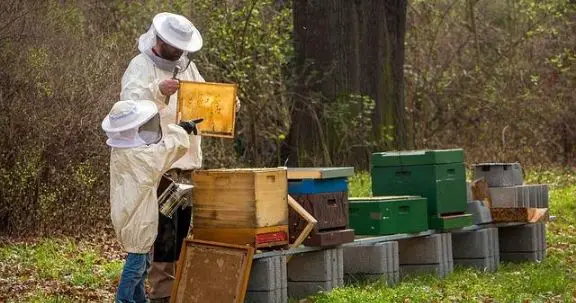Pronounced “war-ray,” these hives were designed by Abbé Émile Warré in France. He called this hive the “People’s Hive.” It’s a vertical hive, so the boxes are stacked on top of each other like with a Langstroth, but instead of adding a new empty box on top as with a Langstroth and the bees build up into it, the empty box gets put at the bottom of a Warré hive and the bees build their comb down, as bees would more naturally do in a bee tree.

This hive was originally designed to have permanent top bars and comb that was fixed to the walls, but there are current designs available with removable top bars. Some designs even have comb guides or frames to help keep them removable. (Most states and localities in the US require hives with inspectable frames. Research your local beekeeping laws.)
Warré’s idea was to make beekeeping easy so anyone could do it with a minimum of work. A quote from his book “Beekeeping for All” that just makes me smile and love his book more, “… beekeeping is a pre-eminently healthy and beneficial activity because it is most often done in the fresh air, in fine, sunny weather.
For sunshine is the enemy of illness just as is the master of vitality and vigor.”And you may not have thought of this as a good reason to keep bees, but he says, “… beekeeping is a moral activity, as far as it keeps one away from cafés and low places.” So, maybe his book and this hive are for you if you’re looking to avoid low places! Hehe.
Warré Pros:
- the 12-inch diameter is supposed to be closer to the “natural” tree hive diameter than a Langstroth hive
- inexpensive compared to a Langstroth hive if built by the beekeeper
- all boxes are the same size/interchangeable
- less frequent inspections than other hives
- no foundation = more natural, fewer chemicals
- crush and strain honey extraction – has pros and cons
- quilt box absorbs moisture – helps reduce associated problems like wet-frozen bees in the winter and mold in the summer
- bees build down, which mimics what they do in a tree = “natural”
- remove the top box full of honey, so automatically remove the oldest, most contaminated comb which is good to remove chemicals that absorb into wax
- the brood is in the newest, least contaminated comb = healthy
- less equipment than a Langstroth
- boxes lighter than a Langstroth
- some experienced Warré beekeepers report they get as much honey as from a Langstroth
Warré Cons:
- more difficult to find a local mentor than Langstroth or Kenyan top bar hive (KTBH), in most of the US
- more complicated to build than a KTBH
- need to put empty boxes under full ones when expanding in the Spring = heavy
- may want/need to build a hive lift = more equipment
- crush and strain honey extraction – as above, has a pros and cons
- if using modified full frames, like with a Langstroth using medium hive bodies, there will be frequent interruptions in comb structure between each hive body as the winter cluster moves up the combs – may be more difficult for the bees to travel in a cluster in northern climes
- top bars – comb more fragile than with frames, special handling must be learned compared to Hoffman frames in a Langstroth hive
- without frames, can be more difficult to split this type of hive (beekeepers “split” hives to make two or more hives out of one to increase the number of colonies they keep)
- maybe more difficult to treat varroa mites than a Langstroth, depending on the treatment used
- can be difficult to assess what’s going on through the observation window compared to doing inspections in Langstroth and KTBH hives
- lifting a Warré box is heavier than lifting a KTBH top bar/comb
- because the comb is destroyed & bees have to rebuild new comb, honey yields may be lower than a Langstroth, new beekeepers are especially likely to get less honey than from a Langstroth hive